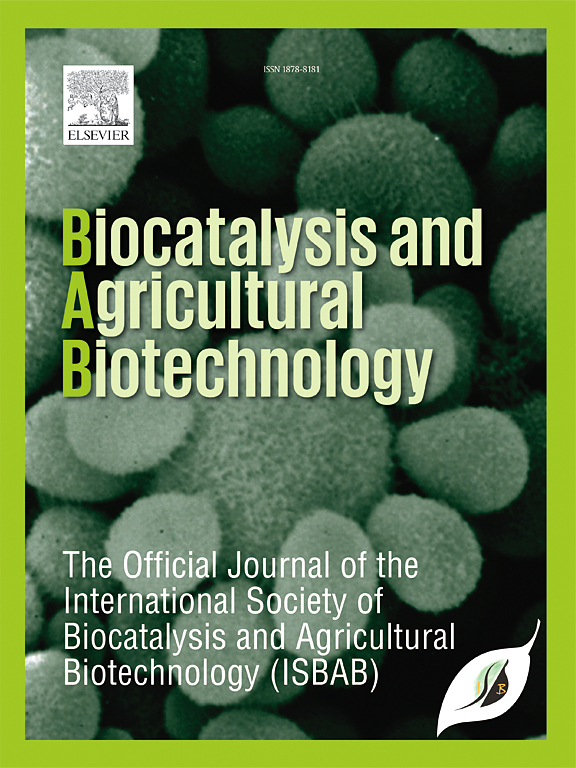Effect of green synthesized ZnO nanoparticles for growth promotion in Pennisetum glaucum (L.) R. Br. validated through physio-biochemical and molecular analysis
IF 3.4
Q2 BIOTECHNOLOGY & APPLIED MICROBIOLOGY
引用次数: 0
Abstract
Zinc is essential for plant metabolism and physiological function. Zinc activates a variety of plant enzyme functions includes protein synthesis, auxin production & regulation, cellular membrane integrity preservation, glucose metabolism, and pollen formation. In this study, zinc oxide nanoparticles (ZnO NPs) at varying concentrations (0, 50, 100, 150, 200, and 500 mg kg−1) were used to observe the effects on Pennisetum glaucum over a 30-day period. The crop plant P. glaucum has been taken as an experimental plant due to its significant place in the food industry. Nanoparticles are green synthesized from Azadirachta indica and investigated using Ultraviolet–visible spectroscopy (UV–VIS), Fourier-transform infrared spectroscopy (FTIR), Scanning electron microscope (SEM), Dynamic light scattering (DLS), and Zeta potential. The synthesized particles had an optimum size of 76.8 nm. Upon treatment of ZnO nanoparticles alpha-amylase, shoot and root length, biomass and photosynthetic pigments of plants increased slightly at 100 mg kg−1 and 150 mg kg−1.The total chlorophyll content of 150 mg kg−1 ZnO NPs treated plants to that of control is around 45.33 % increased after 10 days and 47.75 % increased after 30 days. Upon ZnO NPs treatment, plants also showed a significant increase in antioxidant activity in P. glaucum at 100 mg kg−1 and 150 mg kg−1, whereas, the decline in the percentage at 200 and 500 mg kg−1. Zinc oxide nanoparticles treatment indicated that at higher concentrations, nanoparticles are showing negative effects on free radical scavenging activity. At concentrations of 100 mg kg−1 and 150 mg kg−1 treatment, showed the best free radical scavenging activity and quenched DPPH free radicals by 31.39 % and 42.61 % after 10 days, 48 % and 55.65 % after 20 days and 54.69 % and 55.78 % after 30 days respectively. At the molecular level the expression of Transcription Factors (TF) genes; ERF2 and ERF3 was higher, their activity increased by 7 and 5 folds respectively. The results indicate that 100 mg kg−1 and 150 mg kg−1 application of zinc oxide nanoparticle on pearl millet can enhance crop productivity and at the same time being less harmful for the environment. This study highlights how nanotechnology can be implemented effectively in agriculture at an optimum concentration.
绿色合成ZnO纳米颗粒对狼尾草生长的促进作用r . Br。通过生理生化和分子分析验证
锌是植物代谢和生理功能所必需的元素。锌可以激活多种植物酶的功能,包括蛋白质合成、生长素生成等;调控、细胞膜完整性保存、葡萄糖代谢和花粉形成。在这项研究中,使用不同浓度的氧化锌纳米粒子(ZnO NPs)(0、50、100、150、200和500 mg kg - 1)在30天的时间内观察对狼尾草(Pennisetum glaucum)的影响。由于在食品工业中具有重要的地位,作物植物青光带已被作为实验植物。采用紫外可见光谱(UV-VIS)、傅里叶变换红外光谱(FTIR)、扫描电子显微镜(SEM)、动态光散射(DLS)和Zeta电位等方法对印扎草绿色纳米颗粒进行了研究。合成的最佳粒径为76.8 nm。在100 mg kg - 1和150 mg kg - 1氧化锌处理下,植株的茎长和根长、生物量和光合色素均略有增加。150 mg kg−1氧化锌NPs处理植株,10 d后叶绿素含量较对照提高45.33%,30 d后提高47.75%。在氧化锌NPs处理下,植株在100 mg kg - 1和150 mg kg - 1的抗氧化活性显著增加,而在200和500 mg kg - 1的抗氧化活性则下降。氧化锌纳米颗粒处理表明,在较高浓度下,纳米颗粒对自由基清除活性有负面影响。100 mg kg - 1和150 mg kg - 1处理的DPPH自由基清除能力最强,10 d后分别为31.39%和42.61%,20 d后分别为48%和55.65%,30 d后分别为54.69%和55.78%。转录因子(TF)基因在分子水平上的表达;ERF2和ERF3活性升高,分别提高了7倍和5倍。结果表明,在珍珠谷子上施用100 mg kg - 1和150 mg kg - 1氧化锌纳米颗粒可提高作物产量,同时对环境的危害较小。这项研究强调了如何在农业中以最佳的浓度有效地实施纳米技术。
本文章由计算机程序翻译,如有差异,请以英文原文为准。
求助全文
约1分钟内获得全文
求助全文
来源期刊

Biocatalysis and agricultural biotechnology
Agricultural and Biological Sciences-Agronomy and Crop Science
CiteScore
7.70
自引率
2.50%
发文量
308
审稿时长
48 days
期刊介绍:
Biocatalysis and Agricultural Biotechnology is the official journal of the International Society of Biocatalysis and Agricultural Biotechnology (ISBAB). The journal publishes high quality articles especially in the science and technology of biocatalysis, bioprocesses, agricultural biotechnology, biomedical biotechnology, and, if appropriate, from other related areas of biotechnology. The journal will publish peer-reviewed basic and applied research papers, authoritative reviews, and feature articles. The scope of the journal encompasses the research, industrial, and commercial aspects of biotechnology, including the areas of: biocatalysis; bioprocesses; food and agriculture; genetic engineering; molecular biology; healthcare and pharmaceuticals; biofuels; genomics; nanotechnology; environment and biodiversity; and bioremediation.
 求助内容:
求助内容: 应助结果提醒方式:
应助结果提醒方式:


